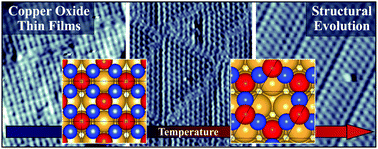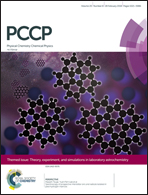Temperature-dependent phase evolution of copper-oxide thin-films on Au(111)†
Abstract
The formation of ultrathin copper oxide layers on an Au(111) surface is explored with scanning tunneling microscopy and density functional theory. Depending on the thermal treatment of as-grown Cu–O samples, a variety of thin-film morphologies is observed. Whereas 1D oxide stripes with Au[11![[2 with combining macron]](https://www.rsc.org/images/entities/char_0032_0304.gif) ] and Au[1
] and Au[1![[1 with combining macron]](https://www.rsc.org/images/entities/char_0031_0304.gif) 0] orientation emerge at 450 and 550 K annealing, respectively, a planar (2 × 2) Cu–O network with specific domain structure develops at higher temperature. The latter is ascribed to a Cu3O2 honeycomb lattice with oxygen ions alternatingly located in surface and interface positions. Strain minimization and a thermodynamic preference for Cu-rich edges lead to the formation of structurally well-defined boundaries, delimiting either triangular, elongated or stripe-like Cu3O2 domains. The low-temperature phases compirse complex arrangements of hexagonal and square Cu–O units, similar to those found in Cu2O(111) and (100) surfaces, respectively. The transitions between different thin-film phases are driven by Cu dissolution in the gold crystal and O2 evaporation and therefore accompanied by a thinning of the oxide layer with increasing temperature.
0] orientation emerge at 450 and 550 K annealing, respectively, a planar (2 × 2) Cu–O network with specific domain structure develops at higher temperature. The latter is ascribed to a Cu3O2 honeycomb lattice with oxygen ions alternatingly located in surface and interface positions. Strain minimization and a thermodynamic preference for Cu-rich edges lead to the formation of structurally well-defined boundaries, delimiting either triangular, elongated or stripe-like Cu3O2 domains. The low-temperature phases compirse complex arrangements of hexagonal and square Cu–O units, similar to those found in Cu2O(111) and (100) surfaces, respectively. The transitions between different thin-film phases are driven by Cu dissolution in the gold crystal and O2 evaporation and therefore accompanied by a thinning of the oxide layer with increasing temperature.

- This article is part of the themed collection: 2018 PCCP HOT Articles


 Please wait while we load your content...
Please wait while we load your content...